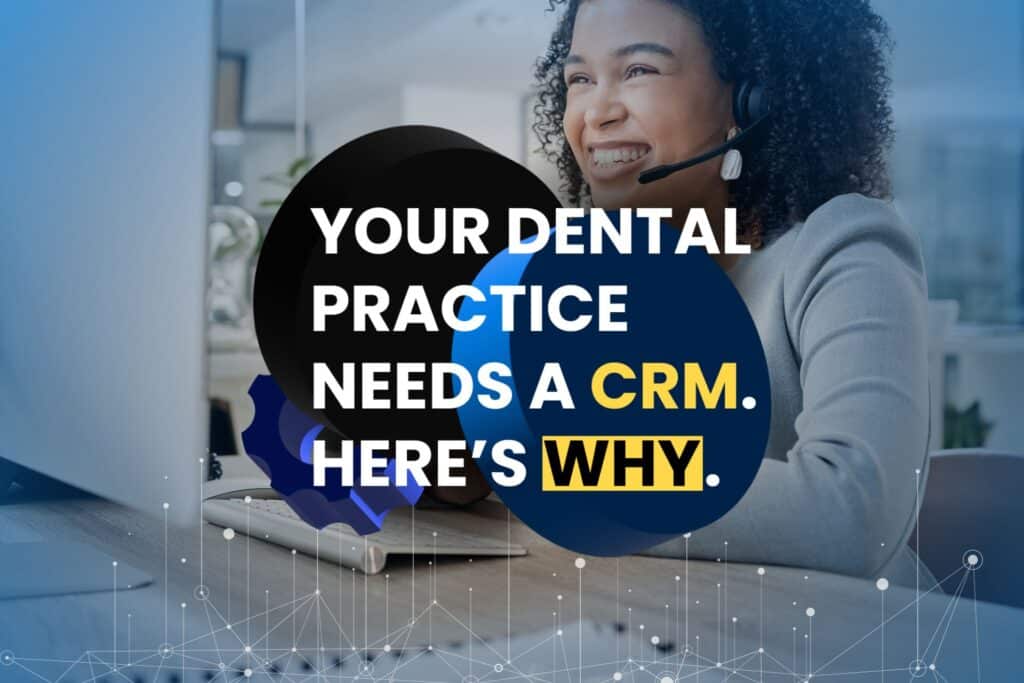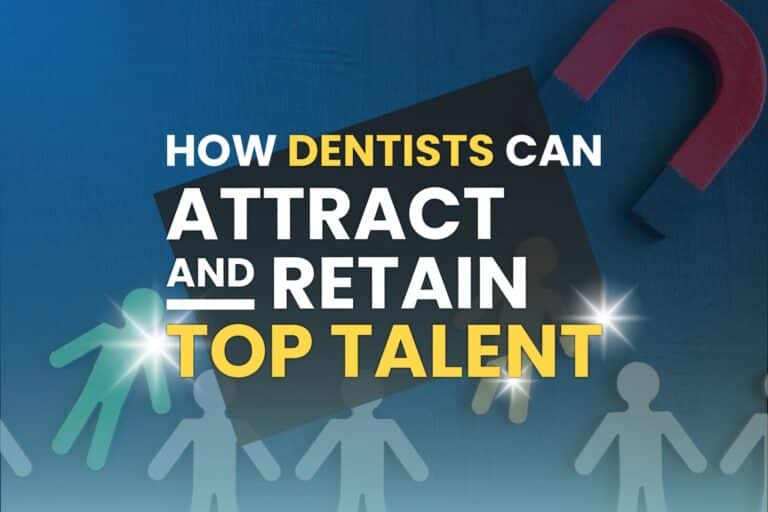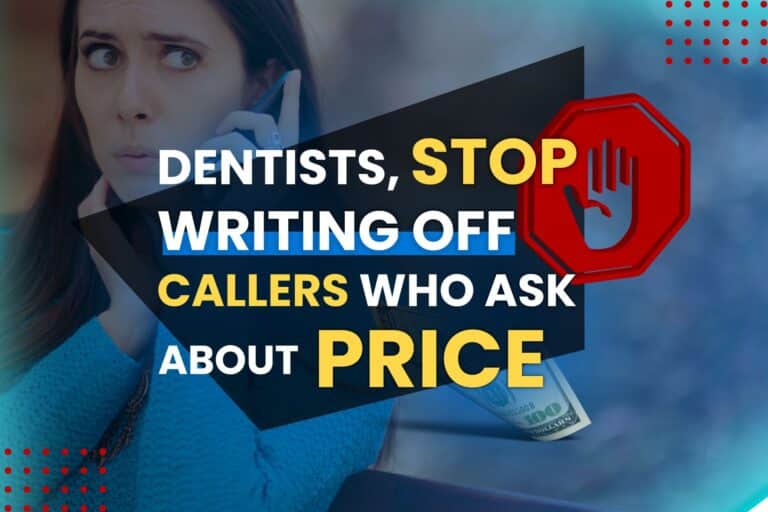A generation or two ago, all a dentist had to do to create patients was hang out a shingle. But today, as the industry grows ever more competitive and corporate, that’s changed.
Dentists and practice leaders need new tools not just to reach their ideal new patients, but build the kind of relationships that will bring those patients through the door and encourage them to accept treatment. Chief among those tools is a contact relationship management platform or CRM.
Keep reading to learn what a CRM actually is, why CRMs are becoming essential for dental growth, and what you need to do before you’re ready to start using one. We’ll also recommend some options you may want to consider.
Let’s go!
What is a CRM and why should dentists care?
If you’ve heard the term CRM before, you probably connect it with platforms like HubSpot or Salesforce, which are used by many larger businesses in industries like e-commerce, tech, and advertising to manage their marketing and sales. What you probably don’t associate it with is dental.
But a CRM is just a tool you use to manage your relationships at scale. It allows you to track everyone who contacts your practice through their entire new patient journey as they progress from a lead to a qualified lead to an appointment to a patient — and to see all of your communications with them in one place.
Dentists need that as much as anybody.
A CRM lets you do two essential things. First, you can nurture your leads over time, maintaining contact with potential patients who may not be ready to come in just yet — but will eventually. Without a CRM, this is almost impossible to do because those leads are too hard to track.
And second, you can identify gaps in your marketing and sales process so you can improve your conversion and closure rates. This will significantly lower your per-patient acquisition costs and increase your overall revenue.
Here’s an example
Let’s say you’re looking to grow your full-arch caseload. You set up a landing page promoting full-arch treatment and run ads to drive traffic to the page.
John clicks on one of your ads, visits your landing page, and fills out a form requesting more information. This adds him to your CRM as a new contact.
Now you can track all of your engagements with him, including your phone calls, emails, texts, and any other contact. You’ll be able to make notes about any barriers to treatment he mentions (like price, fear of the dentist, etc) plus schedule regular follow-up contact so that you continue to stay on his mind even while he explores other options.
By the time John is ready to commit to treatment, he’ll have a relationship with you. And when he comes into your practice for that all-important consult, your treatment coordinator/sales manager will better understand his pain points and what obstacles he needs to solve in order to start.
If you were trying to organize all this data by using a spreadsheet instead of a CRM… it’s likely that none of this would happen. You might make an initial follow-up call when John first fills out the form on your landing page, and maybe even send an email or two, but he would quickly get lost in the day-to-day shuffle.
And most likely, John would end up becoming a patient of the practice down the road that does use a CRM.
Why your practice needs a CRM now (and not next year)
Like we said at the top, dental is changing and your growth strategy needs to change along with it. Here’s why:
- Dental is becoming more competitive. There are roughly 5,100 job openings for dentists each year, against almost 7,000 new dentists who earned their degrees in 2022. And the rate of new dentists is projected to grow by 10.4 percent through 2040.
- Dentists are adding more specialties. More GPs are branching out from the old hygiene and fillings model. The full arch market, for example, is already worth over $1.4 billion and experts expect it to grow by 6.1 percent each year through 2030.
- Insurance payouts are lower. One reason more dentists are pursuing specialties is that insurance pays less than ever. This makes attracting fee-for-service patients (or higher quantities of insurance patients) more urgent.
- Referrals are harder to come by. Patients are more educated about treatment options and price-conscious, so they are more likely to shop around.
- Employee costs are still going up. The Great Hygienist Shortage still plagues dental, and across the board, hiring and retaining talented team members costs more than it used to. Likewise, employees have more options on the hiring market.
All of this creates a climate where more than ever, dentists need consistent, predictable new patient growth. And that means using a CRM.
What if you don’t use a CRM?
We get it — like you need one more piece of software for your team to learn. (Or one more monthly subscription charge.)
Besides, you’ve already got a PMS that stores all your patient data in one place. Why do you need a CRM too?
Well, consider this: A CRM is not the same as a PMS. Your PMS is great for the clinical side of your practice. But it isn’t a growth tool.
A PMS simply isn’t built to track marketing performance or show you where your best patients are coming from so you can target more of your ads there. A good CRM will integrate with your PMS so you can have all of your data in one place — but on its own, your PMS doesn’t allow you to systematically grow. Square peg, meet round hole.
Risks of not using a CRM
If you don’t use a CRM, you’ll struggle to answer four essential questions:
- What are your best channels for generating new patients? This matters because you need to know where to put your money: digital, direct mail, television, etc. If you don’t have clear answers here, you could waste thousands of dollars on unproductive marketing.
- How long does it take to create new patients? Data here helps make your marketing more predictable and gives you the ability to figure out whether patience or a change in strategy is needed.
- What are your conversion rates at each step of your patient journey? The single most powerful way to improve your growth is usually increasing your conversion rates (lead to qualified lead, qualified lead to scheduled appointment or consult, scheduled appointment to patient, etc.). But if you don’t know how well you’re converting, you don’t know what to improve!
- How many opportunities are slipping through the cracks? We mentioned this above, but it bears repeating. Without a CRM, you’ll have no way to keep track of all the potential patients who make initial contact, but then disappear — and no way to figure out how to keep that from happening.
Equally important, you’ll also struggle to establish a consistent new patient journey where your team does the same thing, every time. Because a CRM can automate so much of your patient journey by sending all the right emails, forms, reminders, and follow-ups, it makes creating a repeatable process much simpler and less vulnerable to human error.
How do you choose the right CRM?
Business apps are big, well, business. There are a lot of options out there. How do you choose the right one?
While every practice may be a little different, we suggest following four rules for picking a winning CRM:
- Easy breezy. A good CRM will feel easy to use and make it simple to input data. Once you’ve learned the basics, working with your CRM should never be a stressful part of your day, but something you feel good about. It never hurts to pick one with a good-looking interface, too.
- Integrates with your PMS. If a CRM doesn’t mesh with your PMS, it will make your life harder. You don’t want to deal with jumping back and forth between two different databases. It’s exhausting.
- “One to many” record keeping. It’s a bit technical, but this feature allows you to accurately track when your patients have relationships with each other (like when a whole family comes to you for hygiene treatment). You don’t need to fully understand the mechanics, but you do want to have it.
- One dashboard to rule them all. Your CRM should give you a clear overview of your entire new patient journey so you can see how it all fits together and assess your performance. This should be visual and simple to understand.
CRMs to consider
Here are three CRMs you may wish to consider as you begin your search. Please note all three are HIPAA compliant (don’t use one that isn’t!).
- Trackable. Built just for dental from the ground up and is the only CRM we know of that links to your PMS. We use it with all our clients.
- HighLevel. Also popular with dentists and other healthcare professionals (no PMS integration).
- Salesforce. Leading CRM used by large corporations and tech companies (also doesn’t offer PMS integration).
- We would recommend HubSpot, but unfortunately, it isn’t HIPAA compliant.
Getting more out of your CRM
Now, as we said above, a CRM is a tool. It can deliver powerful results, but you need to use it the right way. As you add one, you’ll want to take some additional actions to help make sure you can get the most value out of it.
First, create a clear 12-month collections goal for your practice. You need to know where you’re going if you’re gonna get there.
Then you should analyze your current tech stack. What apps/tools/software are you already paying for — including those you use for marketing, reporting, analytics, tracking KPIs — and what can you get rid of as you onboard your new CRM?
This may sound like a slog, but you may save yourself time and money in the long run and equally important, reduce the number of passwords you need to remember.
Next, begin setting baseline KPIs. As your CRM comes online, you’ll be able to see how much you’re paying to acquire a new patient through each different marketing channel you’re using: Google, Facebook, direct mail, billboards, or anything else.
By figuring out your patient acquisition costs, you can immediately identify which channels work best for you — and begin figuring out how to make those channels even more profitable.
Finally, don’t be afraid to go over all this with knowledgeable friends, colleagues, or contacts who work in dental. If you’re part of a dental mastermind or entrepreneurs group, ask someone you trust to talk through your data, process, and goals and poke holes in your ideas.
You’ll learn a lot and come out stronger on the other side.
Make your growth sing
We help entrepreneurial dentists generate powerful revenue growth by boosting marketing, operations, and sales. Start with a consult to get a free marketing plan and a discount on our favorite CRM.






